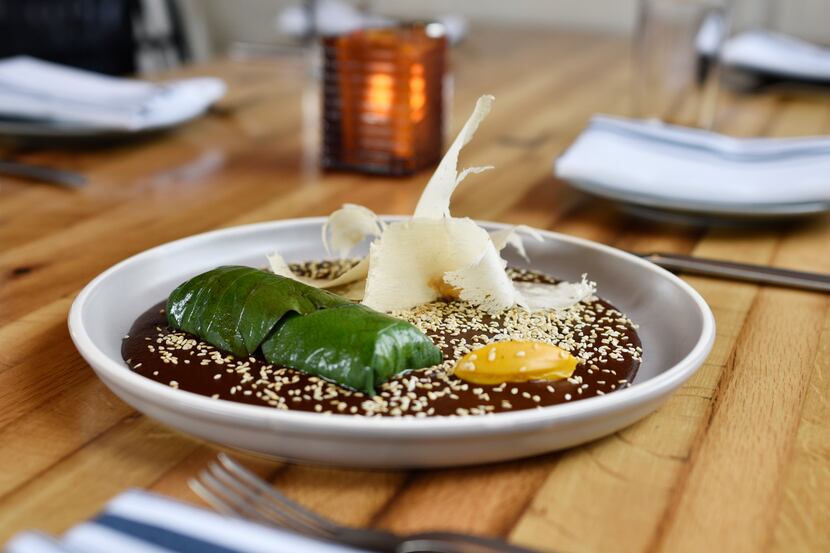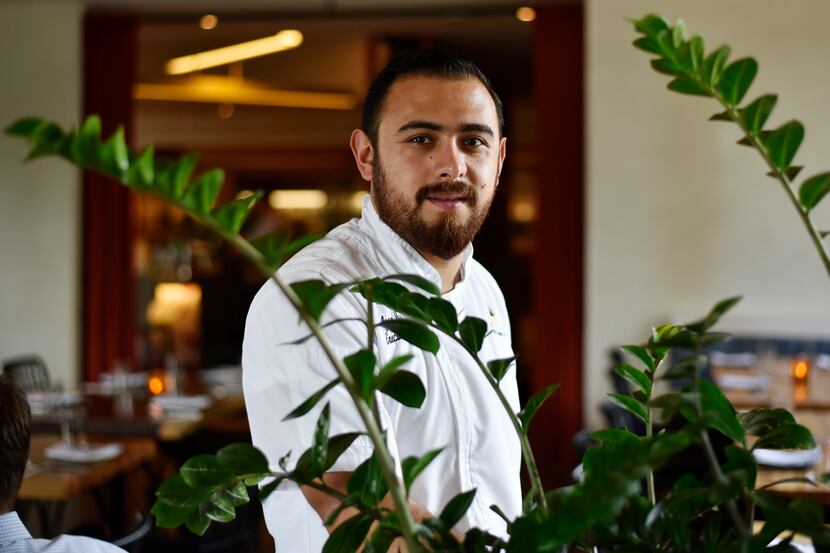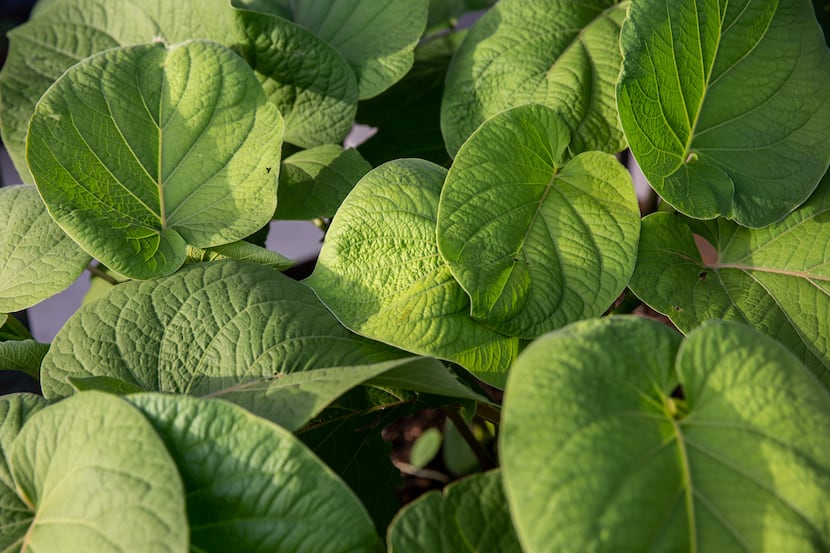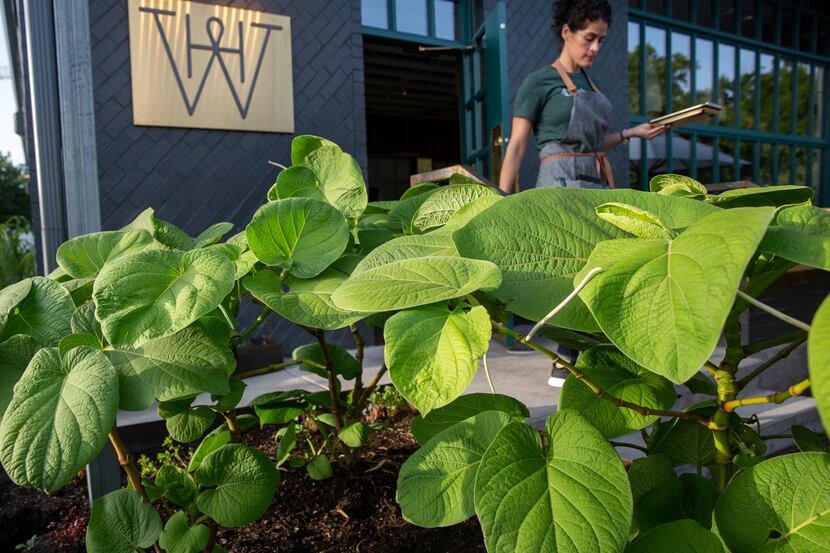You may not have even noticed the dark green, velvety heart-shaped leaf as large as your hand peeking out from underneath a cheese platter. That’s one of its more benign uses, as a natural doily, something to make a plate look pretty.
But Dallas chefs are using hoja santa, the large leafy herb from Mexico, in more interesting ways, because of the unique flavor it imparts on everything it touches. Hoja santa (Piper auritum) means “sacred leaf" in Spanish, and it’s also known as Mexican pepper leaf or acuyo. It’s native to Central America and the North American Southwest, and is commonly used in traditional Mexican cuisine — in moles, pozole, teas, a liquor called Verdìn, and to wrap meat and fish.
It tastes like root beer
“It’s got a really great sarsaparilla-anise kind of flavor profile,” says Matt McCallister, co-founder and executive chef of Homewood. “It’s intense but not overpowering.”
“It’s really an herb,” he says. “I treat it like I would any other herb. Basil also has an anise flavor, and fennel has its own different anise flavor, too. Also tarragon, and they all have unique characteristics. This one reminds me of root beer. It has a little sweeter aroma and a little more perfume than the other herbs.”
McCallister loves using hoja santa in the kitchen so much that he grows it in his restaurant garden. “We’ll take the leaves and make an oil with them and use it in certain dishes,” he says. “Right now it’s essentially chiffonaded and thrown into pasta at the last minute. I’ve used it raw, steamed, to wrap a crudo in it like a sushi wrapper, or cooked over embers on the hearth. I also have a mackerel dish where I cut it into little rounds and set it on top of the fish.”

It’s similar to cilantro
José Meza, executive chef at Jalisco Norte, says that he didn't grow up eating hoja santa in Mexico, but like McCallister, he treats it as he would an herb. "You can chop it, you can leave it whole, you can infuse it," he says. "It gives a touch of fresh flavor to salsas and ceviches."
Meza describes the flavor a little differently than McCallister, though. “It’s anise, mint and cilantro. People either love it or hate it; it’s very strong.”
He sometimes uses hoja santa in a mole, or mashes the whole leaf into the masa before pressing a fresh corn tortilla, which he uses for his soft shell crab tacos and ceviche. There’s an enchilada with Oaxacan sauce, made with chiles and infused with hoja santa on the menu, and he uses it as a garnish for his guacamole. Instead of mint with his lamb barbacoa, Meza uses hoja santa. “It’s a fresh aroma to go with lamb.”

It’s a great pickling spice
Joanne Bondy of Stocks & Bondy has been using hoja santa for ages. "It's been in Texas a long time," she says. "It looks like a grape leaf on steroids."
Bondy likes hoja santa's sassafras essence, which she describes as diminutive rather than overpowering. "I think it's subtle," she says. "I've always used it with subtle foods."
And she likes to use it when pickling just about anything. "You can pickle vegetables and put a small hoja santa leaf in the bottom of the jar and it imparts a fun flavor," she says.

It’s a wrapper of cheese and fish
Dallas wine writer Alfonso Cevola has been growing hoja santa in his East Dallas backyard garden for more than 10 years, and he sells most of it to the Dallas-based Mozzarella Company, which uses the leaves to wrap its goat cheese. “It grows like a weed,” he says. “It’s kind of like bamboo: It just keeps growing and growing.”
Cevola harvests about 1,000 leaves every two to three weeks from spring to early fall, unless it’s a particularly warm autumn, in which case it’ll grow until the weather begins to cool. It’s easy to maintain, and requires very little attention, he says. “They’re self-sufficient,” he says.
Cevola and his partner, Kim Pierce, a freelance food writer for The Dallas Morning News, like to cook with it, too. “Kim will take a piece of halibut and some lemon and olive oil and it’s almost like steaming it in a sauté pan,” he says. "We tried to make a pesto out of it once, he says. “Not advisable, too strong. The last thing this house needs is more pesto. We’re still eating pesto from 2013.”
If you want to grow it yourself, you can find 2-gallon hoja santa plants for $24.99 at North Haven Gardens and at most nurseries. You can also find fresh leaves at various Latin American grocery stores and farmers markets.
Hoja Santa-Wrapped Halibut
“When you wrap the fish, it roasts in the subtle, herbal character of the hoja santa. Don’t be afraid to eat it with the fish after it’s cooked, to further enjoy the flavor, which is something like a cross between oregano and anise,” Kim Pierce says.
2 tablespoons olive oil, plus some to drizzle
2 (6- to 7-ounce) halibut fillets, at least 1-inch thick (also works with any other mild, firm-fleshed fish, such as seabass)
4 hoja santa leaves
Salt and pepper
2 lemons, cut in 1/8-inch slices
Juice of 1 lemon
1 small to medium onion, cut in thin rings
2 tablespoons butter
Preheat oven to 425 F. Spread the olive oil in a glass pan big enough to hold both fillets.
Arrange hoja santa leaves in the pan so you can draw them up around the sides of each fillet. They'll probably overlap for this step.
Place a fillet in center of each arrangement of leaves. Season with salt and pepper. Arrange half the lemon slices on each. (Overlapping is fine.) Then arrange the rings of onion on top of the lemon. Squeeze lemon juice over all. Add tiny dollops of butter to the top of each fillet.
Draw up the hoja santa leaves around each fillet. It doesn't matter whether they're loose or tight. You may need to secure with a toothpick. Drizzle a little olive oil over the packets and rub lightly into the surface of the leaves.
Bake for 12 minutes. Plate and serve. You may wish to tear the leaves open.
How you wrap the fillet depends on the size of the leaves you use. If you use a couple of big ones, it should be relatively easy to wrap the fillet. With smaller hoja santa leaves, you have to create more of a lotus-flower arrangement and pull the leaf points together on top.
Makes 2 servings.
SOURCE: Kim Pierce
